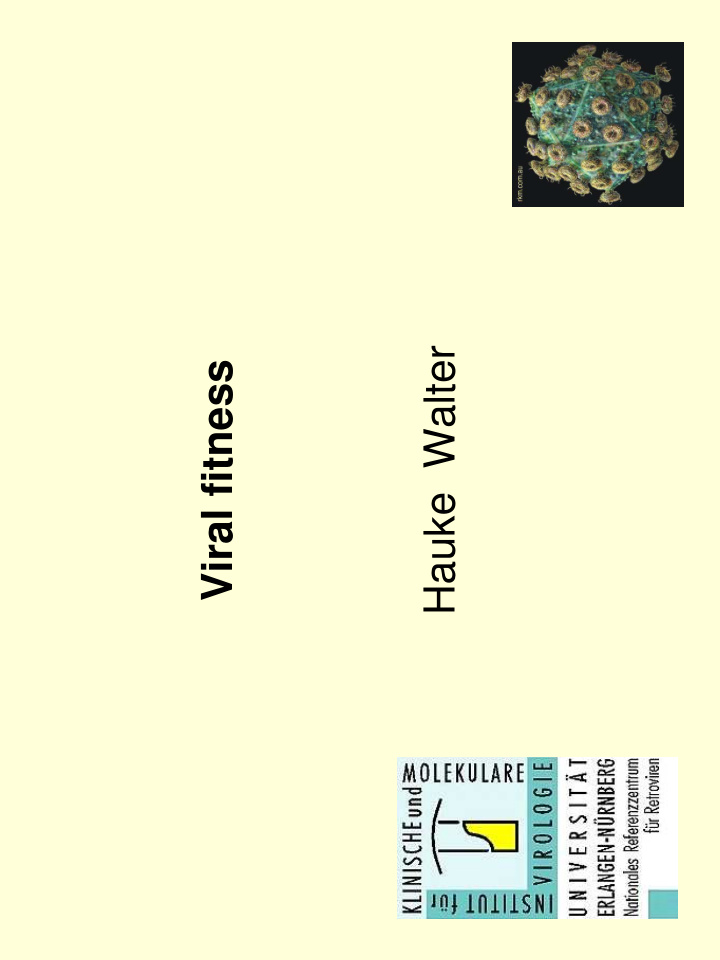



Hauke Walter Viral fitness
Terminological problems • What is viral fitness? The virus adapts due to selective pressure. Therefore the most fit virus is always the majority, because it has the biggest advantage according to the actual pressure(s). Resistance has to be understood as a part of viral fitness.
Genotype - clinical response virologic phenotypic genotypic resistance response changes antiretroviral replicative drug level therapy capacity immune ? response
virological and immunological Less therapy failure Pathogenic? + + VL effective therapy: Cd4 VL Cd4 40% 40% + VL + VL Cd4 treatment failure: Cd4 5% 15% • L. Perrin and A. Telenti: HIV Treatment Failure: Testing for HIV Resistance in Clinical Practice; Science, Vol. 280 June 1998
new replicative capacity (RC) assay 1.39 1.39 1.39 50µl viral SN 1.93 1.39 2.69 5.17 19056 SEAP activity /1000 20 18 16 saturation 14 12 10 NL4-3 8 6 4 2 0 1 4 10 27 72 192 514 1376 3687 9878 -2 1/dilution (increase of infectious dose)
determination of replicative capacity (RC) • determination of SEAP activity NL4-3 of 30 different IDs day3 the produced NL4-3 solver 25,000 infectivity 20,000 SEAP activity saturation 15,000 9.726 10,000 background • 5,000 by infection of new cell 0,000 cultures 1:1 after 3 days 0 1000 2000 3000 4000 5000 6000 434.8 1/ dilution factor •Same curve but other ID SEAP activity NL4-3 of 30 different IDs day6 (according to day 0) NL4-3 25,000 solver • dependent on viral growth 20,000 SEAP activity saturation 15,000 behaviour 9.958 10,000 background 5,000 0,000 0 100 200 300 400 46.9 1/ dilution factor
example: relative RC of different viruses day 3 day 6 increase day3/day6 RC NL4-3 434.8 46.9 9.27 100% virus 1 990.2 183.8 5.39 58% virus 2 459.9 233.3 1.97 21% • small interassay variability: 1.27-fold
summary – RC determination upsides of competitive replication assays is biased by – cell culture saturation – Differences in the RC in order to find ONE infectious dose fitting for all viruses –Variability of the assays determining the infectivity in cell culture supernatants (higher than the differences of RC ) – Combining the determination of supernatant infectivity and RC in the same assay was helpful – Results were obtained detecting quantitavely the production of new infective particles over time
Acknowledgements Vivantes Auguste-Viktoria Institute for Virology Hospital, Berlin, Germany (Erlangen, Germany): C. Weber Monika Tschochner H. Stocker Sabine Wittmann M. Kurowski Christiane Paatz K. Arasteh Tim Engel Wolfgang Ruhland Bernhard Fleckenstein Institute for Bioinformatics (Saarbrücken, Germany) : Institute for Virology Tobias Sing (Cologne, Germany): André Altmann Rolf Kaiser Hendrik Weisser Jens Verheyen Thomas Lengauer Martin Daeumer Lots of others..
Recommend
More recommend